Vacant land development: Benefits of raw land
Are you an aspiring property investor or developer looking to get into raw land development? If so, there are a few things you should know before you take the plunge.
Vacant land development refers to the process of turning undeveloped land into something valuable and habitable by building on it. This can be achieved in many different ways, depending on your needs and the type of land you're working with, but all land development projects share some common elements and steps.
Here are some of the basics of raw land development, from buying parcels of land to marketing and selling your finished product.
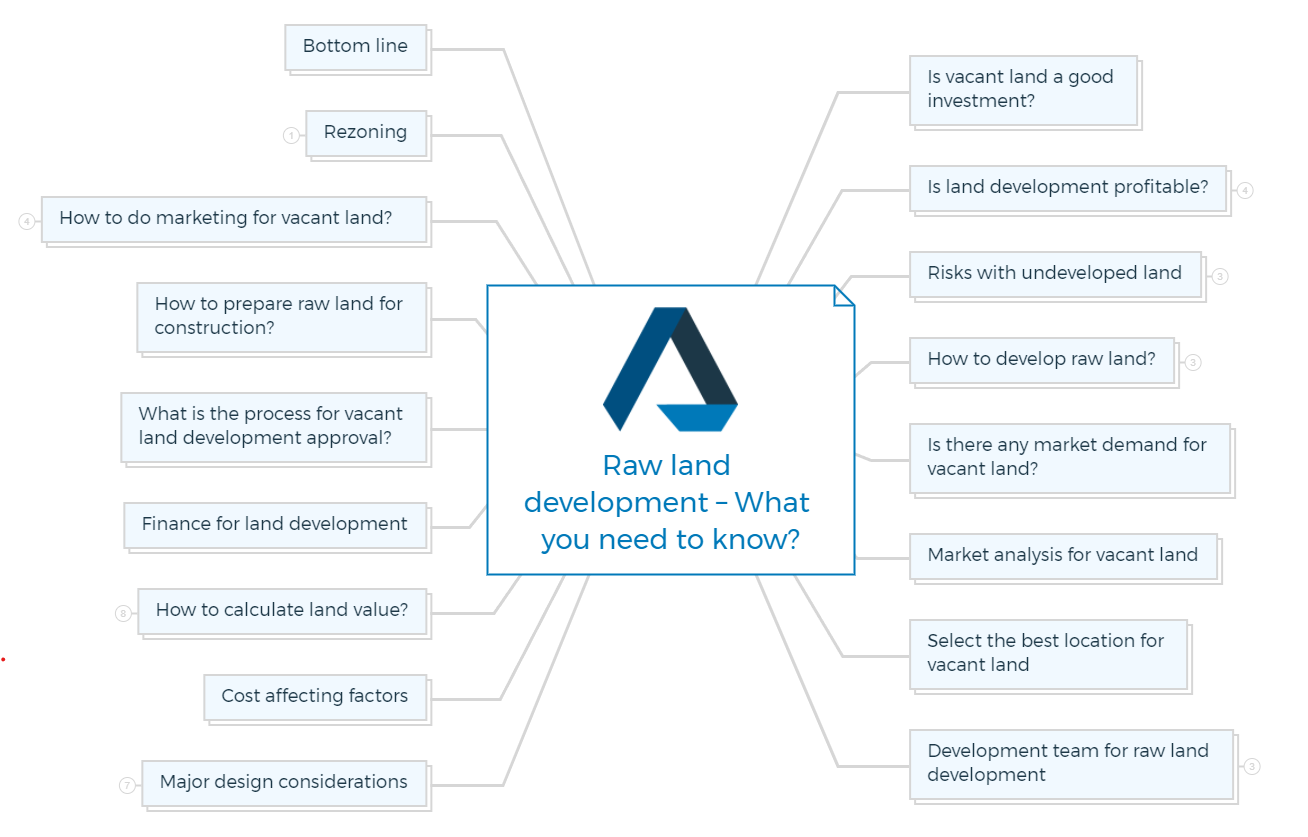
Is vacant land a good investment?
We can't replicate land; thus, it can be a precious asset depending on its location and site circumstances. Areas near a river or coastline, or places with exceptional vistas, have witnessed a significant increase in value, indicating a demand for good quality land.
The advantage of holding raw land is the possibility to increase its value. Vacant land can be subdivided or rezoned, with the resulting portion(s) of land being sold for more than the initial purchase price, including subdivision or rezoning fees.
When undeveloped land is not providing money, the owner often loses the tax benefits of developed property. If an investor or developer wants to keep raw land, they'll need a lot of cash to cover repayments, service fees, and other expenses.
Investing in raw land can be considered from two different angles:
- Land speculation
- Redevelopment and resale.
Regarding land speculation, the investor expects to keep the property until a change in land use occurs or demand is developed due to urban expansion.
On the other hand, the land developer intends to engage in entrepreneurial activities on the property, such as applying for a rezoning of land use and subdivision, installing infrastructures such as roads, water, sewerage, gas, and electricity, and then profitably selling the various subdivided portions.
Is land development profitable?
The profitability of land development depends on two factors: location and timing. To maximise your chance of making money from developing raw land, look for areas with high population growth, high-income growth and proximity to employment centres.
Following are some reasons why land development is beneficial.
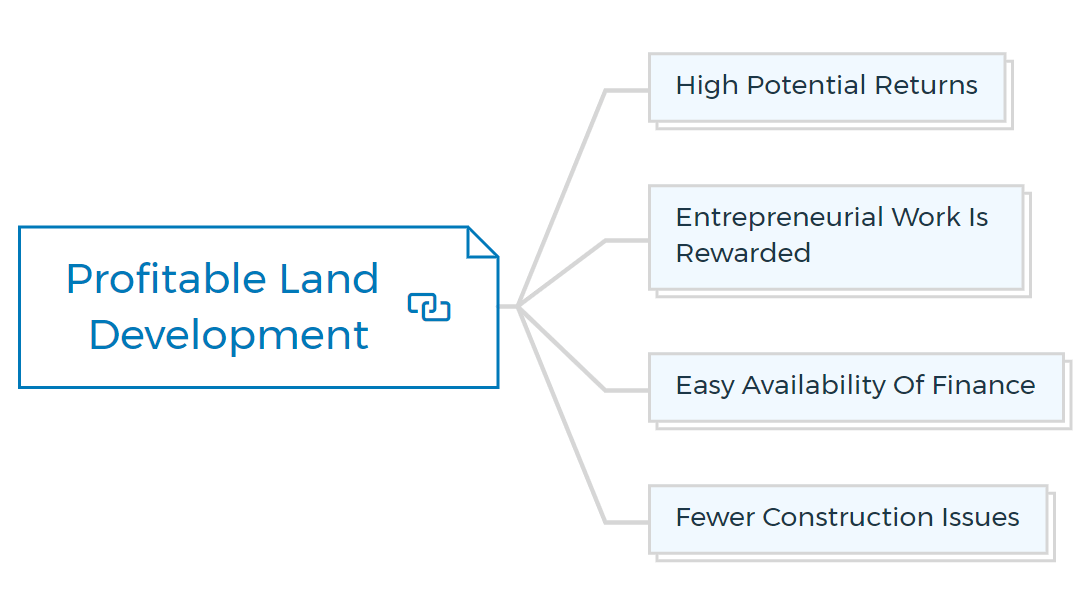
High potential returns
As previously said, a well-located property can become a valuable asset, mainly when natural forces such as population growth and migration create a desire for new zonings.
When rural land is rezoned to urban, the value of the land purchased at rural land prices is revalued at a much higher rate per square metre.
Entrepreneurial work is rewarded
Visionary developers are often rewarded for their entrepreneurial efforts. For example, some developers have made billionaires overnight by analysing a city's growth patterns and purchasing vast tracts of unused government property, rezoning it, and selling the subdivision as residential and commercial building lots.
Easy availability of finance
Most funders will be willing to lend money for vacant land if the timing, location, and feasibility studies show a good return. This funding is sometimes contingent on the property being rezoned.
Fewer construction issues
Dealing with a natural resource that only requires roads and essential utilities to make it usable entails fewer headaches and financial commitments than dealing with new construction.
Furthermore, compared to a new building, where the developer will only receive payment after the structure is completed, land can be sold much sooner, lowering the holding cost or interest charges.
Risks with undeveloped land
The risks associated with raw land development are primarily determined by the timing factor, along with the following points.
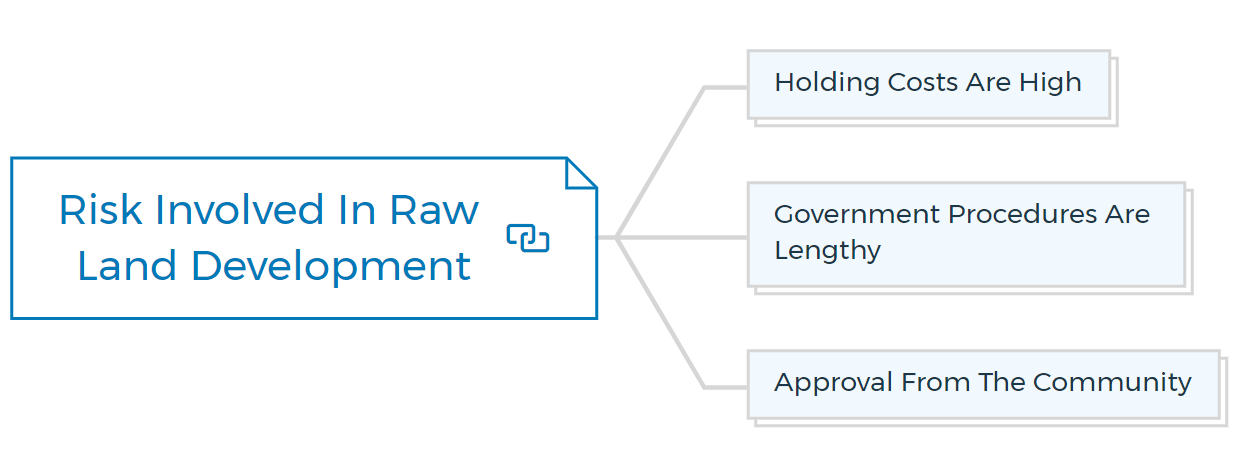
Holding costs are high
Long-term speculative land purchases might have substantial holding costs, especially if the land cannot be rented for a specific purpose or sold beforehand. Delays in rezoning or subdivision approvals can be costly to a developer because they will be paying interest, land taxes, and professional fees without any cash flow or return from the land.
Government procedures are lengthy
Any rezoning or subdivision of land triggers a slew of government processes, including municipal and state agencies.
Some government procedures may mandate the developer to do particular studies, such as an environmental impact assessment, a traffic effect analysis, and a social impact study, depending on the size and location of the site.
Approval from the community
There may be several local active communities and action groups who voice concerns about the rezoning's influence on the residents and environment, in addition to the usual government approvals. If these concerns are not addressed, it may slow down the property development process.
In the world of property development, risk management is critical. Follow Risks In Property Development – Industry Insiders Guide for tips and tricks for succeeding with a practical approach to all types of risk in this industry.
How to develop raw land?
To be successful in land development, you must be continually aware of any changes in government planning policies and maintain track of urban expansion. You can do so by going to your state's planning authority and getting the most up-to-date planning material on current and future policies.
Now that you have this information, you have the following alternatives for approaching your development.
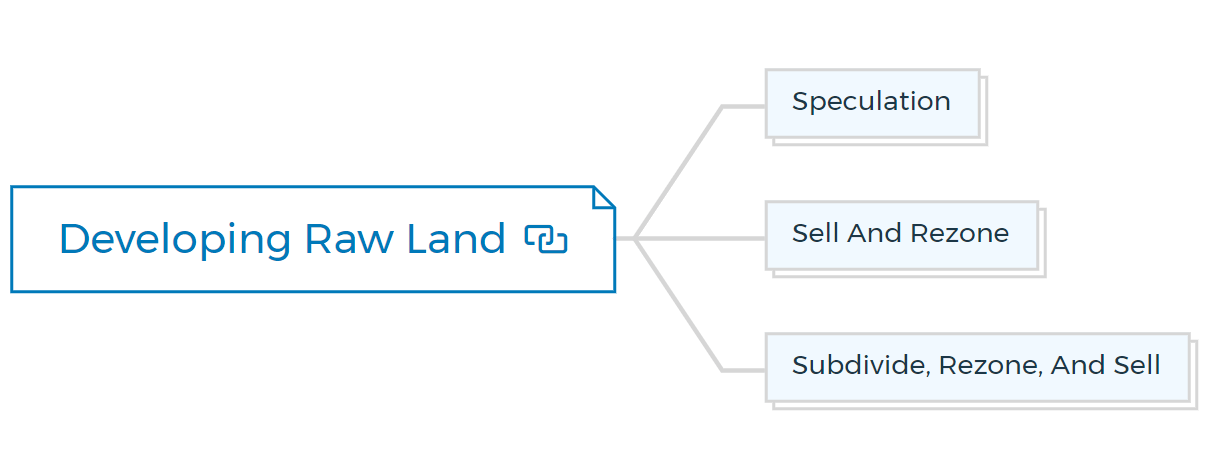
Speculation
Long-term and short-term speculation are both possible. The long-term premise involves buying a big piece of rural land, waiting for urban sprawl to approach, and then selling.
Short-term speculating requires being informed of any impending planning adjustments, purchasing land that will be affected by the changes and then selling at a higher price.
Sell and rezone
Rezoning and selling entail purchasing the land outright or based on a conditional option. It will take time and effort to ensure that the rezoning is effective and then sell the land to another developer willing to build the structures.
Subdivide, rezone, and sell
Rezoning, subdividing, and selling is used to rezone, subdivide, and sell residential or large industrial land plots. The developer creates an overall township plan following government planning policy and long-term structure plans.
Before being sold as individual lots, the application will go through standard government procedures.
Assessing market demand for vacant land
Land development follows the same rules as other markets and is subject to market pressures.
Because successful land development is dependent on the land's eventual use, you should examine the variables associated with specific real estate uses while analysing market demand.
The following is a list of the main variables to be investigated:
- Population variation
- The economy's transformation
- Effect of government policies
- Alterations in the economic structure of the community
- Availability of land
- Social services
Market analysis for vacant land
Conduct market research in the following areas to identify potential purchasers for the subdivided lots:
- Consumer demographics and profile
- Proof of previous sales
- Infrastructure that has been carefully planned
- Competitors
- Forecasting sales
- Future profits
The research can be assisted by real estate brokers, property valuers, or expert market researchers.
Select the best location for vacant land
You will need to spend time researching land acquisition and staying up-to-date with the state planning authorities' future planning rules to locate the best location for land development.
Your investigation should also consider the long-term planning of road and rail transportation infrastructure and the movement of people closer to job possibilities. Avoid environmentally sensitive locations, which may cause rezoning and subdivision applications to be delayed.
Avoid natural wetlands and low-lying ground and waste sites such as former garbage dumps, regions with high overhead power lines, and land near airports or heavy industrial zones.
When looking for the perfect location, consider all of the land's future uses, which could include residential, office, retail, or industrial.
Development team for raw land development
The number of consultants on the team will vary depending on the scale of the project. Still, in addition to the developer or project manager, the town planner, civil engineer, and land surveyor are three other consultants who play an essential role in rezoning and subdivision.
The following is a list of their respective services:

Town planner
Depending on the project's scope, you may use the services of a town planner from the beginning to the finish. The planner's skills are most needed in the early stages when he will perform a variety of studies and consultations with various authorities to offer a conceptual layout sketch with a planned subdivision and zoning. The planner will prepare a thorough structural plan with the help of other consultants, which will serve as the framework for the various subdivisions and will be submitted to various authorities for approval. A municipal planner will draft the application and motivation documents for council approval if the rezoning is required.
Civil engineer
In the early stages, you will need a civil engineer to evaluate service opportunities and limits with the appropriate authorities. Water, electricity, and gas authorities, the local control for road and stormwater management development standards, telecommunication service providers, and the government's transportation and environmental protection departments are among them.
The engineer will inspect the land and look into the soil and vegetation types, groundwater, existing services, terrain, and other factors affecting the town planner's raw land development costs and planning.
The engineer will develop precise drawings and specifications in cooperation with the other team members, issued for tendering to civil contractors. It is critical to retain the services of an engineer to oversee the construction process.
Land surveyor
You will need a land surveyor at two stages of the project's development: at the start and the end. The surveyor will prepare a complete survey of the land to be developed at the beginning of the project, covering all existing elements such as trees, water features, services, and so on. The surveyor will formalise the subdivision by drawing diagrams and pegging out the subdivided land so that titles may be issued after the subdivision is completed and approved by relevant authorities.
Various other consultants
You will also need some other consultants, but they will likely play a minor role:
- Structural engineer
- Environmental scientist
- Geotechnical engineer
- Anthropologist
- Architect
- Landscape architect
- Property Valuer
- Real estate agent
- Advertising and marketing professional
- Lawyer
Get The Edge Now!
Discover the transformative power of our FREE EDGE platform and
unlock a world of opportunities at no cost!
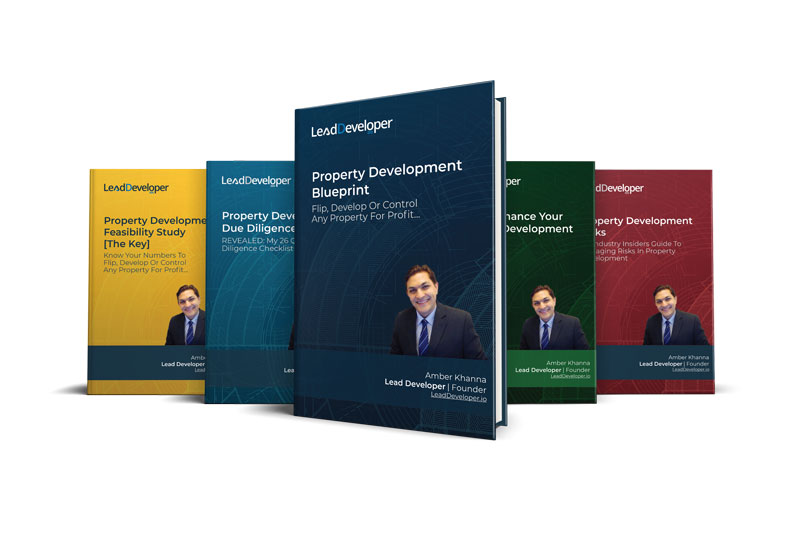
Your Real Estate Toolkit Awaits!
Free eBooks, Courses & Feasibility Suite Trial—Join Today!
✓ Unlimited FREE Trial: Experience the full power of our Feasibility Suite with hands-on demos
—explore without limits, no time pressure & without commitment or credit card!
✓ Learn from Success: Dive into real-life case studies for practical insights.
✓ Engage, Inquire, and Innovate: Ask questions, request features, and engage in lively discussions.
✓ Showcase Your Projects and Gain Insights: Share your projects and get personalised feedback.
✓ Free Resources Galore: Access a treasure trove of free resources,
eBooks & courses to keep you informed.
✓ Exclusive Training: Enjoy members-only training to sharpen your skills.
Major design considerations
Consider the following design elements -
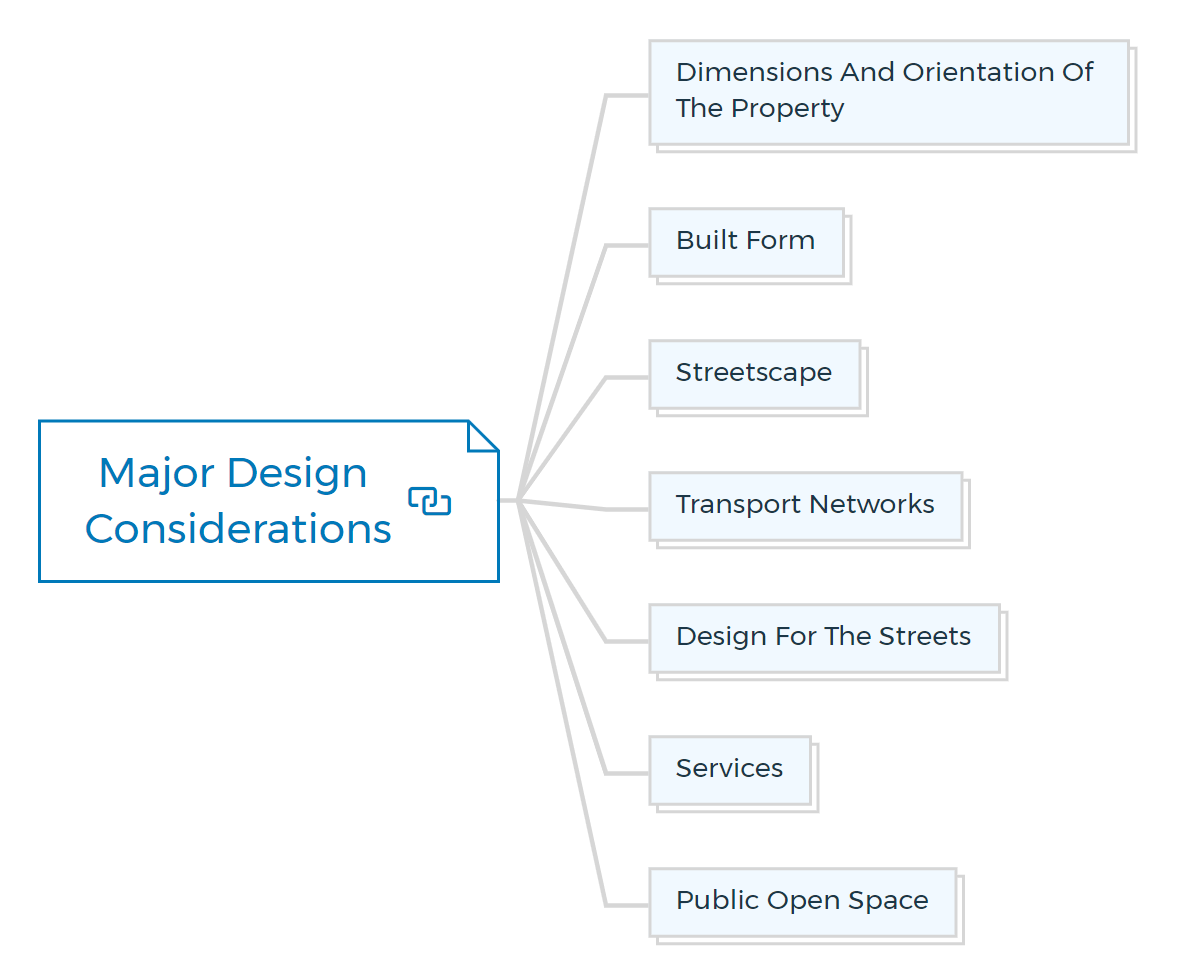
Dimensions and orientation of the property
There is a lot of variation in the size and orientation of lots across your country's states. For instance, in Australia's states, the average lot size used to be roughly 500 to 800 square meters for detached dwellings.
Many local governments are now encouraging a range of lot sizes ranging from 400 to 450 square meters to achieve cost efficiency. Australian households are shrinking, and people's lifestyles are shifting to include more time spent on leisure activities outside the home.
As a result, homeowners don't have as much time to manage a large garden as they once did. When developing for smaller lots, the planning team should consider the following factors, where appropriate:
- The land's natural curves and orientation, as well as the conditions of the soil
- The requirement to preserve unique features such as trees and views
- The cost-effectiveness of new and existing services
- The necessity of avoiding unnecessarily repetitive actions
- The ability to aid energy conservation by ensuring proper solar orientation
Built form
Although the final design and planning of residences on each lot is not part of a land developer's financial feasibility, considering the following design considerations will help with the marketing strategy:
- The homes' scale, height, and density
- A general housing theme or personality
- Privacy, natural light, and energy conservation.
- Various setbacks and building lines
- Provision of a private outdoor area
- Parking
Streetscape
In a vacant residential land subdivision, the design and character of the streetscape are essential in determining the value and image of the properties. It also has a significant impact on neighbourhood identity.
The following elements contribute to the streetscape's value.
- The formal and informal landscaping's quality
- Natural greenery and existing trees are preserved
- The utilisation of terrain and natural features
- Widths of the verge (the area between the lot boundary and the roadway) and street paving design
- Street furniture, such as poles and signs, is controlled and designed.
- Architectural styles under supervision
- Fence height and material are created and maintained.
Transport networks
The design team should start with the most sensitive elements of transportation, which are the needs of pedestrians and cyclists when preparing the overall conceptual site layout.
The primary highways should have gentle grades and connect residential areas to schools, parks, and community activity centres. One needs to eventually consider the design of possible bus routes and the expansion of the roadway network.
For safety, traffic effect, and noise, residential streets should have low traffic volumes and speeds.
Design for the streets
Aside from the public transportation network, the design team should pay special attention to the detail and design of the street layout, taking into account such like:
- The breadth of the street reserve (the area set aside for future road widening) and the width of the pavement
- Distances and sightlines (clean vision lines for vehicles approaching intersections)
- Design and markings for streets and pavements
- Spinning rounds to make room for garbage trucks and fire trucks
- Public transportation provisions
- Street illumination, as well as street furniture
- Pedestrians and bikes will be accommodated.
The provision of pedestrians and bicycles must be a vital component of the overall transportation network design. Residents should be able to walk or ride their bikes to community facilities.
It's especially crucial to design for the safety of children, the disabled, and the elderly, especially when they have to cross a busy street.
Services
Water supply, sewerage, electricity, gas, telephone, and stormwater are typically provided through a series of underground ducts within the road reserve or at the back of a lot in residential subdivision developments.
Independent authorities oversee these utilities, and no attempt has been made in the past to integrate installation, except a single agreed-upon location for each service.
Recently, there have been attempts to share trenches, which has the following benefits:
- Cost-effectiveness with fewer trenches and minor construction
- The precise location of maintenance and repair services
- Reduced verge width
- Reinstatement and earlier settlement.
Public open space
Local governments usually specify the minimum amount of open space required to ensure a sufficient amount is planned at the design stage. The continuous maintenance of these spaces has recently become a concern for local governments.
Therefore, when developing areas for open space, it's necessary to strike a balance between current and future use and ongoing maintenance requirements.
Cost factors
While the initial cost of land subdivision development may be comparable to other developments, the construction cost breakdown will differ because no buildings are involved.
The expenses that one needs to consider when conducting a feasibility study for a land subdivision development are listed below:
- Land value when purchased
- Rezoning
- Subdivision
- Services in bulk
- Expense of building
- Cost of holding
- Escalation costs
- Fees for development managers
- Consulting fees for professionals
- Insurance
- Transportation and other statutory levies
- Road widening
How to calculate land value?
When you are looking to invest in raw land, one of the most important things you need to figure out is what the property is worth. Determining the vacant land value can be tricky- there are a number of ways to do it, and not all of them will give you an accurate estimate. Here are 8 steps for estimating the value of vacant land.
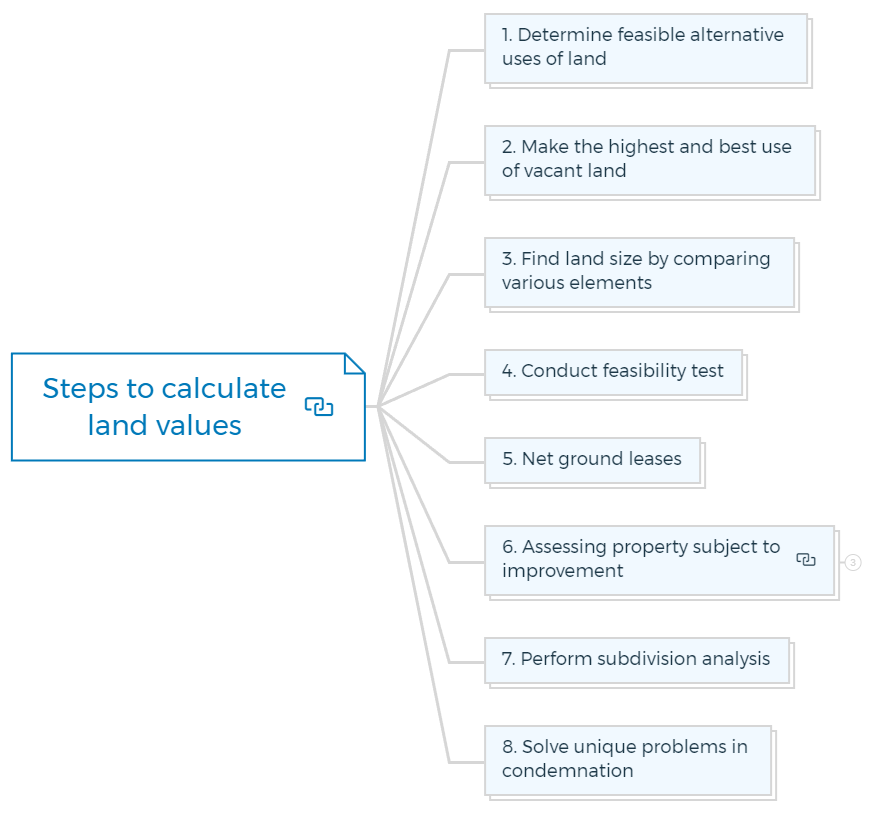
1. Determine feasible alternative uses of land
The majority of collected residential properties and commercial properties have potential other financially viable uses. Future preservation will be influenced by identifying practical alternative applications because the value of development rights determines the donor's eligibility for tax credits.
Collectible lands can generate money from mining, oil and gas, wood, and other natural resources, even for the more mainstream investor. Lands may be leased for various uses, temporarily or permanently.
You can achieve an outstanding value split by holding a remaining stake in the land while leasing it to a commercial user. The commercial user enjoys the current practicable usage and pays rent by it, while the landowner keeps the capital gains.
Conceptually, the discounted present value of expected income and the DCF of anticipated capital gains determine an asset's worth:

Of course, things become interesting because the present "revenue" can come from either rents or investments. Practically speaking, the value of any income-producing asset depends on its potential annual income and any potential capital gains upon selling.
Take a look at the direct capitalisation land valuation formula:
Direct capitalisation land valuation process

The capitalisation of current income (NOI) is accounted for in this formula, but the capitalisation of the eventual resale is not.
The NOI capitalisation itself buried the eventual selling. The capitalisation of future cash flows at the moment of sale would be the only factor in determining value.
If we don't count things like selling costs, paying off loans, etc., we could say that the value of a project with constant NOI and an expected sale in a year is:
Value with constant NOI

Even though it may all seem blatantly obvious, it highlights a crucial fact regarding pricing in general and the valuation of land holdings in particular.
The valuation technique is immaterial, assuming a constant cap rate, R0, and the same discount factor for current income and future gains.
For one, the cap rate is merely a comparison between the predicted, steady NOI and the price existing real estate investors are willing to pay for that unending supply of NOI.
As real estate performance impacts and modifies investor expectations, expected NOI and R0 fluctuate frequently and quickly.
Second, even in a dream world where NOI and property investor expectations don't change, the cap rate for highly speculative future gains will differ from the cap rate for much less speculative current income.
Therefore, the investor's future plans for the property type may have a significant impact on the projected present value.
2. Make the highest and best use of vacant land
For a developed site, we consider the highest and best use (HBU) as if it were vacant, accounting for the expense of tearing down any existing improvements and getting the property ready for reuse.
The HBU needs a reverse determination—what is the value as if developed—for a land that is already vacant. Any ethically correct, physically practical, and economically viable usage could qualify as HBU.
An existing developed site frequently has a bias in favor of continuing to use "as is." The HBU is a blank canvas with only a range of possible applications as restrictions while the site is unoccupied.
Consider a location with commercial zoning that could be transformed into one of the following four structures: offices, apartments, standalone restaurants, or light retail. The table below reflects raw land development.
Alternative HBU Calculations

It's interesting to note that the project's overall worth is not more than the value assigned to the location. Building an office complex will cost $10,100,000 to develop but will only generate a profit of $1,100,000.
In contrast, building light retail will cost less to complete but will provide an enormous profit of $1,600,000. Therefore, in this case, HBU calls for light retail growth.
Mixed-use land developments are becoming more and more prevalent today. For starters, zoning and land use regulations may stipulate that mixed-use be permitted in densely populated urban areas.
On the other hand, mixed-use can increase rents and create synergies between different land uses, even in suburban or less densely populated areas. The HBU for a vacant site may therefore involve optimising several applications rather than being a straightforward solution.
Usually, this is a two-step procedure. The most significant amount of space the market will accept will be considered first, typically in terms of square footage. Additionally, we will consider the smallest square footage that can be built and maintained.
Building a complex with 50 or even 100 apartments might be possible. However, running a 10-unit apartment complex could not be profitable or marketable to investors.
Second, think about the expenses and earnings per square foot. Standard features, such as green space, meeting spaces, community use spaces, or other recreational spaces that may be required by ordinance or enhance the overall site's marketability, will also need to be considered.
3. Find land size by comparing various elements
How do we calculate the size of the vacant land? Acreage? Based on square footage? Or something altogether different?
First, it is essential to be aware of surplus and excess land.
Any area of the property not currently required to support the existing improvement and does not have a separate highest and best use is considered surplus land. Surplus land may have no intrinsic worth.
A factory might need a 10-acre site to construct the building, supply parking for employees, and construct ramps for vehicles and exterior fixtures. The additional 2 acres offer little value if the location is 12 acres. Because there are two additional acres, no buyer of this factory will pay more.
Surplus and excess land
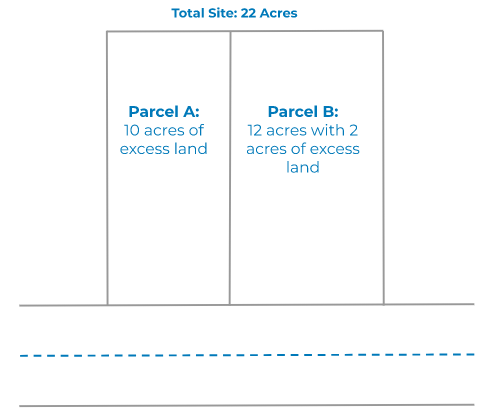
On the other hand, surplus land could have a unique highest and best use and value.
Use the same scenario, but suppose the site is 22 acres instead of 12. The additional 10 acres have contributed value because they might be individually sold off as a location for a different factory of a comparable type.
Learn More
Consider a plot of land in a typical, unexceptional, mainstream neighborhood. The lots in the development were initially meant to be roughly the same size and sell for roughly the same price or something similar.
Creating cookie-cutter lots will typically be defeated by considerations like topography, street design, preservation of trees and other vegetation, local land use regulations, and the desire to create an attractive neighborhood. Some lots will indeed end up being significantly more prominent than others.
Some lots may be much larger and more private, particularly at the ends of cul-de-sacs. The average lot in a relatively affluent suburban neighborhood may be 8,000 square feet in gross area, but a few may be closer to 10,000 or even 12,000 feet.
In the report's assumptions and limiting circumstances, appraisers admit that they lack surveying expertise and often rely on land measurements from surveys or publicly available data.
As a result, the degree of precision and the units of measurement directly relate to the calibre of the underlying data sources. If the survey or tax assessment map showed square footage, the appraisal report also shows square footage.
To ascertain whether the value estimations are accurate and sufficient and whether the development or rental value is sustainable, readers of appraisal reports must carefully examine the quality and sufficiency of the site description.
4. Conduct feasibility test
If the potential earnings from an investment property can cover a reasonable rate of return on its entire cost (including indirect expenditures), that is, if the expected value upon completion is equal to or greater than the estimated cost, then the property is economically feasible.
Economic feasibility is established for any other non-real estate investment if the venture turns a profit. The weighted average cost of capital (WACC), which incorporates a return on equity investment, is one implicit cost for a project.
The "fair return" is typically broken out as a separate line item in real estate analysis. This is due to the possibility that various alternative site uses may have various needed rates of return.
Always combine sensitivity analysis with the feasibility analysis for every specific planned site use. To figure out different valuations, key variables should be changed for various possible outcomes.
To make an accurate Monte Carlo simulation, you can give these possible outcomes probabilities. Lenders are looking for these kinds of simulations more and more, and they often call them "stress tests."
Several essential parts of a feasibility analysis need to be looked at carefully. These things are:
- Do some market research.
- Find the best combination of tenants or the best set of uses for a mixed-use proposal.
- Determine assumptions in detail.
- Find the acceptable range of those assumptions.
- Ensure simplicity.
- Separate the variables under the investor's control from those that are not.
An excellent feasibility study will rank the options for the investor and calculate the value differential between the best option and the other options.
The investor has a tool that may be used and reviewed during the project management phase if the feasibility study outlines the impact of control factors separately from external variables.
These should be included in an appraisal, but they lack depth and complexity too frequently. Know your number with instant access to the Property Development Feasibility Suite.
5. Net ground leases
A net ground lease enables a renter to develop a plot for a time. The improvements and the land revert to the landlord after the lease is over, subject to any option or renewal conditions.
Taxes, insurance, and maintenance fees are the tenant's responsibility for the lease term, while the landlord will likely maintain general liability insurance and incur monitoring, legal, and accounting costs.
Most leases have terms of 20 years or longer, while net ground leases with terms of less than 10 years are uncommon. Major chain store tenants often have ground leases.
In contrast to standard triple net leases, net ground leases place no responsibility for the building on the landlord. The renter is often in charge of maintenance, which may be specified in the lease.
In a net ground lease, the tenant constructs the building (sometimes with landlord approval) and is in charge of all costs throughout the lease term.
There are typically two types of ground leases: subordinated and unsubordinated. To allow the tenant to finance the development, the ground owner consents to give construction or permanent lenders a lower priority in the first case.
The landlord essentially takes on the role of a junior lender for the project. The penalty of this subordination is typically a higher rent and additional concessions from the landlord.
In an unsubordinated lease, lenders will often still lend to tenants with good credit; they'll just consider the lease when figuring out how much they can lend.
Theoretically, there is no distinction between the value of a net ground lease and any other contractual cash flow with a remaining interest at the end of the term. Of course, the difficulty with land leases is that the residual value is a topic of considerable speculation.
Many ground leases are simply valued as raw land without considering the lease. For the investors, the ground lease or leases becomes more critical. While underlying quantification (matched pairs, trend lines), specific changes are significant and loaded with assumptions.
The starting point for any negotiations will always be the reconciled value from such an appraisal, even though the actual investment value can be quite different.
6. Assessing property subject to improvement
You wish to purchase a plot of land for renovation or investment, but there is already a structure there. There is a considerable difference between the seller's perception of the property's "value in use" or "investment worth" and your assumption that the HBU is for demolition and reconstruction.
You employ a valuer to estimate the tract's value "as if vacant." This is simple if there are sufficient neighbouring unoccupied land sites. The appraiser will turn to a land extraction if there are no comparable local properties or if they are insufficient to support the valuation.
We value the entire property and then deduct everything that is not the vacant land to create a cost method that works backwards.
Finding sales or rent comps can be challenging, given HBU's controversy. The reader may erroneously concentrate on the land value without paying enough attention to the underlying assumption when interpreting and using the appraisal.
A building for an HBU move can have suffered much depreciation. Depreciation may, in fact, equal or come close to equaling the replacement cost. The "completely depreciated" structure may nevertheless receive rents or other benefits, which is a paradox to be aware of.
The rentals are frequently insufficient to support a "value in use" yet sufficient in many circumstances. In appraisals, you may identify more techniques with varying degrees of accuracy. These consist of:
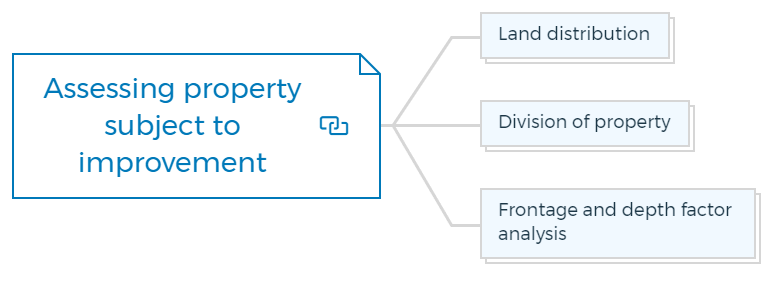
Land distribution
Tax assessments are used as leverage in this. The tax assessor divides the fair market value (FMV) between the land and the improvements in the majority of jurisdictions.
The allocation ratio may be fair even if the total FMV is off. Therefore, comparing the allocations of similar properties to the sales prices of nearby homes with comparable sites may provide insight into the site's worth.
Division of property
The evaluation may look at the expense of developing unimproved tracts into improved tracts and raw land. It is beneficial when there are many neighboring sales of raw land but few sales of improved sites.
Frontage and depth factor analysis
Site depth may be a deciding issue, especially in some metropolitan areas, as long as the site width is sufficient to comply with HBU's "physically practicable" and "legally permitted" standards.
Frontage may play a decisive role in high-amenity settings (such as beachfront property). When there is some dissociation between value and site size, both methods may help find values.
7. Perform subdivision analysis
Many parcels are bought to develop or divide them. Although land can be divided for residential and commercial uses, when the phrase "subdivision" is used, it typically connotes a residential community.
Industrial parks and out-parcels from shopping centres are two popular non-residential subdivision investments.
The sales comparison approach is typically highlighted when the appraisal is being used for loan purposes.
Four stages are used to value the land:
- Undeveloped property in need of development (the "as-is" condition)
- The developed lots as if sold at wholesale (such as a builder purchasing bulk lots)
- Land with the entitlements, permits, and all legal prerequisites to begin construction.
- The worth of completed lots after deducting the cost of marketing (a DCF model)
The land development analysis is separated from any subsequent site uses, even when a developer doubles as the end user, like a homebuilder or a retail centre developer. As a result, the land development ROI, feasibility, and valuation must be self-sufficient.
Reviewing the process of developing the undeveloped property into a subdivision of homes or businesses may be helpful. Almost always, this takes several years to complete.
Subdivision developments are "phased in" over several years since land development takes time. A developer may decide to construct 1,000 homes on a plot measuring 250 acres if the market can support 200 new residences annually.
Some infrastructure will need to be erected initially, but much of this may wait. Finalized plans frequently change over time. The market need could change, causing the next phase to switch to bigger or smaller lots or possibly another purpose (such as condominiums rather than single-family homes).
It gives the developer considerable flexibility and eliminates the requirement for an upfront financial commitment. The analysis will include discounted cash flows, just like any project with erratic cash flows.
From month to month, cash inflows and outflows will vary greatly, and the risks associated with each could be highly different. As a result, several discount rates might be used.
Finally, launching a project of this scale is unusual without sophisticated funding. Even in the planning stages, the capital structure must be integrated with the valuation research.
8. Solve unique problems in condemnation
There are disagreements among appraisers regarding enterprise value versus real estate value in large shopping complexes because they are collections of contractual connections.
There are many distinct schools of thought regarding this appraisal issue, especially in hotels, and various allocations may cause the appraisal to be located in various areas.
The figure below illustrates how two distinct appraisal procedures may produce the same overall value but use a different methodology to assign value to specific sub-components.
Different approaches to allocating value
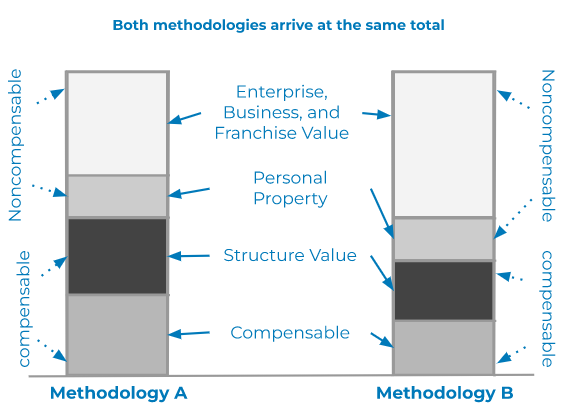
An investor may favour one allocation above another for tax-related reasons. Recall that real estate (land and structures) usually is compensable in condemnation proceedings, but business values (everything else) are not.
A similar issue frequently affects hotels. The site value of a hotel can be significantly impacted by the loss of parking, especially if the property is a convention hotel and depends on parking.
Some approaches could classify the loss as non-compensable commercial site value, while others might see it as having an outsized impact on the entire hotel real estate site value.
Investment-grade real estate is frequently the target of inverse (regulatory) condemnation actions and physical condemnations. Investors, especially their attorneys, frequently make poor decisions when taking these steps.
Finance for land development
The feasibility analysis, but more crucially, the project's cash flow following the anticipated stages or phases, will determine whether or not finance is approved for a subdivision land development.
Early in the development process, one should approach financial institutions to understand the project as the concept develops.
Before approaching a lender, make sure you have the following information on hand:
- A historical overview of the land and its environs
- A summary of the project as well as any distinguishing features
- A report on the property's value
- The specifics of the market research
- Information on the development firm and its shareholders
- Information on the borrower's financial situation
What is the process for vacant land development approval?
Land subdivision permission differs from building development approval in that it involves many state and municipal governments, environmental organisations, and utility companies.
Each state has its development approvals process, in which you can take help from a local town planner or state planning department. You can understand the development process in detail with my article of 18 crucial steps for the development approval process.
However, keep in mind that each method will be different depending on the local government authority in charge of the area.
How to prepare raw land for construction?
The procedure for clearing the subdivision should begin once tender processes have been followed and a civil contractor has been hired to carry out the building work.
The appointed civil engineer should schedule inspections with various authorities to ensure that all necessary services have been installed correctly, such as earthworks, roads, and stormwater drains. All construction work must adhere to the approved blueprints and any additional conditions imposed by the relevant authorities.
As soon as the job is finished, submit 'as constructed' drawings for the issue of certificates of title. Remember that the contractor's obligations end after a 12-month maintenance period. The contract should retain 2.5 percent of the contract sum, which will be released at the end of the maintenance period.
How to do marketing for vacant land?
You may choose to undertake 'in-house' marketing or hire professional advisors such as real estate agents, depending on the size of the development and the allocated money.
Through various media types such as newspapers, radio, pamphlets, and so on, the marketing exercise would create a particular community lifestyle. The start of the marketing campaign will be determined by a strategy developed based on the previous study.
The following factors drive a marketing programme:
- Whether pre-sales are a requirement for funding the project's start-up.
- The current market situation and competitiveness
- Marketing research indicates that customers want to view the finished product before committing.
Aside from those above, there are other marketing strategies that successful developers are using.
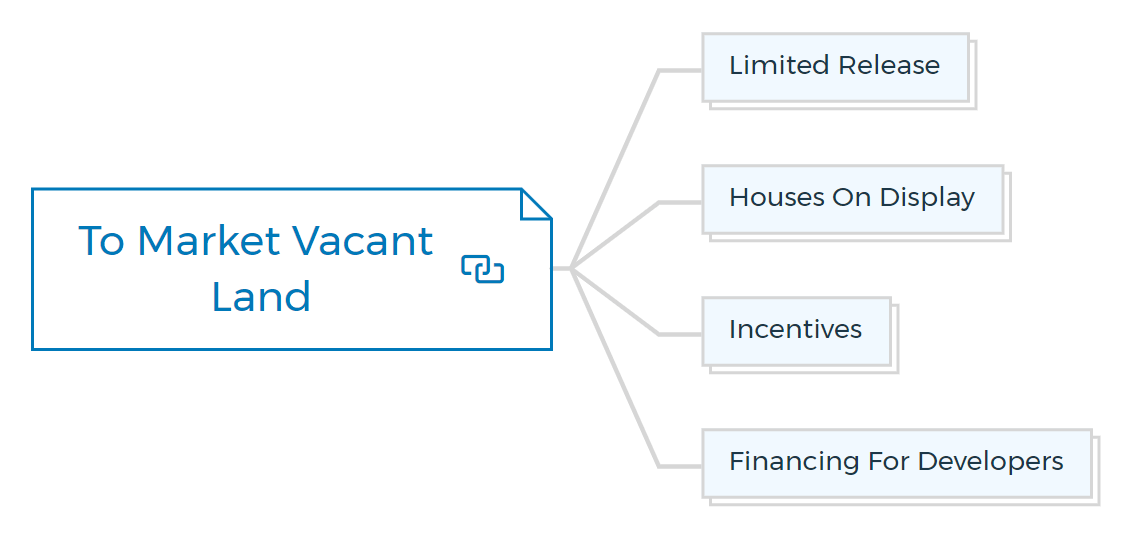
Limited release
The development will be released in stages if the limited release method is used. Each step has a finite number of lots, and there are always more purchasers than available lots, creating a "must buy" mentality before the price rises at the following step. Market conditions will determine the effectiveness of this strategy.
Houses on display
Most new land developments will have a few lots accessible for project builders at the entrance. This serves a dual purpose: it gives the project a more regular appearance.
Most project builders spend a significant amount of money on their promotion, luring vast groups of potential purchasers to the property.
Incentives
Various incentives can be used to entice purchasers, such as free fence or landscaping or a monetary discount on the early completion of the new home.
Financing for developers
Having the developer's financier provide financing to potential buyers would benefit the developer, the buyer, and the financier. They will have already appraised the land and may offer better terms and conditions to buyers.
Rezoning
Rezoning a property from its current use to more commercially valuable zoning can bring substantial financial rewards to astute developers with vision and drive. This can be accomplished, for example, by purchasing a vacant piece of residential land and rezoning it to a shopping district.
The new zoning would have attracted a higher market value if the ground had remained residential. However, as described above, this is easier said than done because the developer will face several challenges.

Restrictions
Governments can regulate and control the specific use of land by restricting zoning. These zonings are in the public interest because they promote public health, safety, and welfare.
Zoning regulations should not be arbitrary, unfair, or discriminatory, and they should be clear, detailed, and simple to understand.
Possession of a rezoning permit
Local governments must consider the following factors when granting a rezoning to an existing town planning scheme:
- Whether the suggested alternate zoning will be compatible with the surrounding area's overall character
- Whether the suggested alternative zoning is socially desirable to the community and its environs
- Whether the motivation of the applicant is personal or in the public interest
Obtaining rezoning as a strategy
Rather than focusing solely on the scheme's benefits, applicants who successfully secure rezoning approval focus on their presentation (detailed drawings and written papers to support rezoning) and strategy.
This is accomplished by having a thorough understanding of the elements that influence rezoning proposals, such as:
Mistrust
Residents generally do not trust developers, which is regrettable but true. This is mainly due to past unscrupulous developers. Your growth plans will almost always involve bringing additional people into the neighbourhood, altering the environment, and changing traffic patterns.
These changes cause concern, with citizens occasionally objecting to any idea without weighing the pros and cons.
Local politics
Be aware that local politics may become involved and that local councillors will have different perspectives on various issues. You should learn about these viewpoints or beliefs and tailor your presentation to address or avoid these challenges.
Public costs
Any rezoning will incur additional costs, such as essential services and increased traffic. Your presentation must persuade all parties involved that your proposal would benefit the community and not impose undue burdens.
Different viewpoints
Recognise that the local planning authorities, interest groups, and residents will all have other points of view than you. It may be beneficial to check with these organisations before submitting your application.
The presentation of your plan should address any issues positively raised by these various bodies.
Bottom line
After reading this article, you're undoubtedly asking yourself, "Why to build or develop a property?" Why not sell the land as is? It is essential to rehabilitate land for two reasons:
- A property that has been substantially developed is worth significantly more than one that has not been designed.
- A built property generates cash while also providing tax benefits, but a vacant site is costly to maintain.
Some developers focus solely on land development. These developers devise long-term development strategies and buy semi-rural land three to five years (or longer) before urban sprawl encroaches on their investment.
To do the same, you'll need a sufficient amount of cash to go through this period of low income and the patience to wait for the anticipated windfall.
Mastermind your first property development project with a property mastermind course.
FAQs

